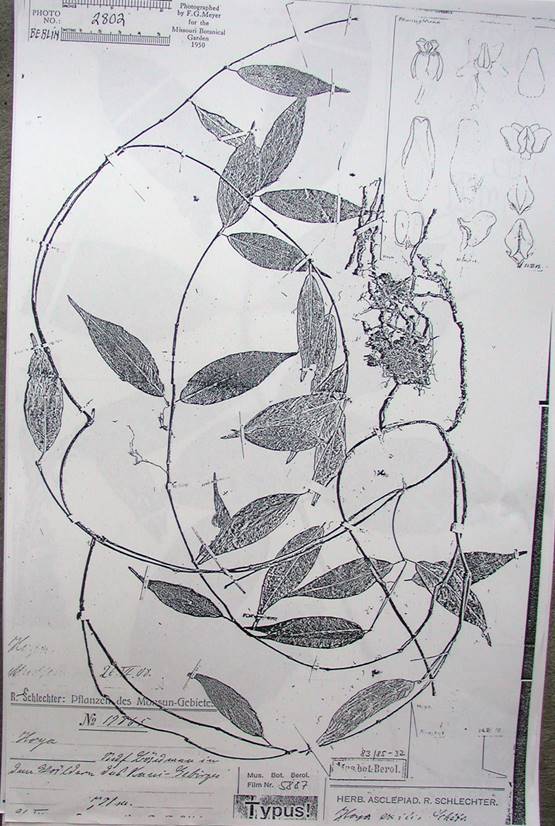
Hoya exilis Schlechter 1913
Type description:
In Botanische Jahrbücher 50 (1913) 121. “Die Asclepiadaceen von Deutsch Neu Guinea” R. Schlechter. 28. H. exilis Schltr. n. sp. — Suffrutex gracillimus, exilis, parum ramosus, scandens. Rami filiformes, flexuosi. laxe foliati, teretes, glabri. Folia patentia vel patula, elliptico-lanceolata, obtuse longi-acuminata, textura pro genere tenuia, utrinque glabra, petiolo glabro, superne leviter sulcato. Inflorescentiae umbelliformes, 6 — 15 florae, pedunculo pedicellisque gracillimis filiformibus glabris. Flores in sectione inter minores, subglabri. Calycis foliola parvula, lanceolato-ovata, usque ad tertiam partem basilarem 5-fida, extus glaberrima, intus basi minute puberula, caeterum glabra, lobis recurvis, rhomboideo-ovatis, acutis. Coronae foliola patentia, superne oblonga, apice adscendentia, breviter acuminata, extus obtusa, lateribus rotundato-incrassata. Pollinia oblique ovalia, translatoribus brevissimis, retinaculo rhomboideo, minuto.
Ein äuszerst zierlicher Schlinger mit fadenförmigen, locker beblätterten Zweigen, Blatter sehr dünn von Textur, 5 - 10 cm lang, in der Mitte 1.5 - 3.3 cm breit, Blattstiele 0.4 - 0.7 cm lang. Blütenstände doldig, 6 - 15 blütig, auf sehr schankem, 5 - 6 cm langen Stiel. Blütenstiele sehr fein fadenförmig, 1.5 - 2 cm lang. Kelch sehr klein, Zipfel ca. 1 mm lang. Korolla 1.1 cm in Durchmesser. Koronaschuppen kurz und fleischige, vor der Spitze bis zum äuszeren Rande kaum 2 mm überschreitend.
Nordöstl. Neu-Guinea: auf Bäumen längs der Gebirgsbäche von Albo, ca. 300 m. u. M. (Schlechter n. 16172. — Blühend im Juni 1907); auf Bäumen in der Waldern des Kani-Gebirges, ca. 700 m. u, M. (Schlechter n. 17865. — Blühend im Juni 1908).
Eine schon äuszerlich durch die sehr dünnen Zweige und die auffallend dünne Textur der Blatter leicht zu erkennende Art. Die geringe Blütengrösze bringt sie neben H. chloroleuca Schltr., doch sie in den Koronaschuppen sehr verschieden vor jener, Die Blutenfärbung ist grünlich-weisz.
Translation: See article below.
Other literature:
In Hoyas of Northeastern New Guinea (1992) 57-58. “Translation of Die Asclepiadaceen von Deutsch Neu-Guinea: R. D. Kloppenburg. 28. Hoya exilis Schlechter n. sp.—An extremely slender, small, not very branched climber. Branches threadlike, flexible, loosely leaved, round, glabrous. Leaves spreading or outspread, elliptic‑lanceolate, obtuse, long‑acuminate, texture for the genus thin, both sides glabrous, petiole glabrous, above slightly grooved. Inflorescences shaped like umbels, 6‑15 flowered. Pedicels of the peduncle very slender, threadlike, glabrous. Flowers among the smallest in the section, almost glabrous. Leaflets (lobes) of the calyx small, lanceolate ovate, subacute, glabrous, much shorter than those of the corolla. Corolla somewhat rotate, 5‑parted all the way to one third from the base, outside glabrous, inside at the base minutely puberulous, central portion glabrous, lobes recurved, rhomboid‑ovate, acute. Leaflets (scales) of the corona spreading, above‑oblong, with the apex ascending, shortly acuminate, outside obtuse, sides rounded‑fleshy. Pollinia obliquely‑ovate, with the translators very small, retinaculum rhomboid, minute.
An extremely pretty clinging vine with threadlike loosely leaved branches. Leaves very thin textured, 5 ‑ 10 cm. long, in the middle 1.5 ‑ 3.3 cm. wide. Petioles 0.4 ‑0.7 cm. long. Inflorescences umbellate 6‑15 flowered, on a very slender peduncle, 5 ‑6 cm. long. Pedicels very fine, threadlike, 1.5‑2 cm. long. Calyx very small, lobes about 1 mm. long. Corolla 1.1 cm. in diameter. Corona scales short and fleshy, from the apex to the outer rim barely over 2 mm.
Northeastern New Guinea: on trees along mountain brooks of the Albo, about 300 meters altitude (Schlechter #16172—Blooming in June 1907); on trees in the Kani Mountains about 700 meters altitude
(Schlechter #17865—Blooming in June 1908).
A beautiful species, easy to recognize by means of its very thin branches and the diminished, thin texture of the leaves. The small bloom size brings it near H. chloroleuca Schlechter, however it is very different from that one in the corona scales. The coloring of the blooms are greenish-white.
In The Asclepiadaceous Works of Friedrich Richard Rudolf Schlechter (1992) 30. A. Nicholas. H. exilis Schlechter (Schlechter 17430, 19410) – 15.
In Hoya Dr. Schlechter’s Hoya Species (1993) 62. R. D. Kloppenburg. Hoya exilis Schlechter. An extremely slender, small not very branched climber. Branches threadlike, flexible, loosely leaved, round, glabrous. Leaves spreading or outspread, elliptic-lanceolate, obtuse, long- acuminate, texture for the genus thin, both sides glabrous, petiole glabrous, above slightly grooved. Inflorescences shaped like an umbel, 6-15 flowered, pedicels of the peduncle very slender, threadlike, glabrous. Flowers among the smallest in the section, almost glabrous. Lobes of the calyx small, lanceolate-ovate, subacute, glabrous, much shorter than from the corolla. Corolla somewhat rotate, 5-parted all the way to one third from the base, outside glabrous, inside at the base minutely puberulous, central portion glabrous, lobes recurved, rhomboid-ovate, acute. Scales of the corona spreading, above oblong, with the apex ascending, shortly acuminate, outside obtuse, sides rounded-fleshy. Pollinia obliquely-ovate, with the translators very small, retinaculum rhomboid, minute.
An extremely pretty clinging vine with threadlike loosely leaved branches. Leaves very thin textured, 5-10 cm. long, in the middle 1.5-3.3 cm. wide. Petioles 0.4-0.7 cm. long. Inflorescences umbellate 6-15 flowered, on a very slender peduncle, 5-6 cm. long. Pedicels very fine threadlike, 1.5-2 cm. long. Calyx very small, lobes about 1 mm. long. Corolla 1.1 cm. in diameter. Corona scales short and flashy, from the apex to the outer rim barely over 2 mm. Northeastern New Guinea: on trees along mountain brooks of the Albo, about 300 m. altitude (Schlechter #16172 - Blooming in June 1907); on trees in the Kani Mountains about 700 m. altitude (Schlechter #17865 - Blooming in June 1908).
A beautiful species easy to recognize by means of its very thin branches and the diminished, thin texture of the leaves. The small bloom size brings it near H. chloroleuca Schlechter, however it is very different from that one in the corolla scales, The coloring of the flowers are greenish-white.
Published by Dr. R. Schlechter in: 1913 Botanische Jahrbücher V.50 p.121, “Die Asclepiadaceen von Deutsch Neu Guinea".
Hoya exilis Schlechter, 1913, Type # 17865 (B)
